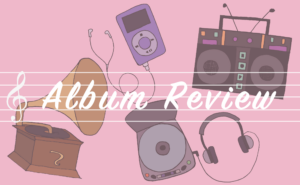Some music you dance to, but some you simply sit with and feel. Katie Gavin’s debut solo album What A Relief is undeniably the latter.
The past two years have been major for MUNA’s Katie Gavin. As one third of the self-proclaimed “greatest band in the world,” Gavin and her bandmates grew to queer pop-icon status with the anthemic “Silk Chiffon,” featuring Phoebe Bridgers. Since then, they have commanded stages with boygenius, opened for Taylor Swift on the Eras Tour, and headlined All Things Go Music Festival (stepping in for Chappell Roan at All Things Go Maryland after she canceled her performance). How do you follow such a hot streak? For Gavin, the answer is surprising: go quiet, go personal, go solo.
What A Relief is more than an album—it’s a diary entry, penned over seven years with honesty and vulnerability. The cover alone, which shows Gavin in a cluttered bedroom littered with clothing, pill bottles, and a rosary, sets the scene. What A Relief is an album about intimacy, trauma, and everything in between, and with a folk-inspired simplicity, its themes are both deeply personal and universally relevant.
The album’s opener, “I Want It All,” pulls no punches. Gavin sings, “I want you to see me when you’re not looking / I want you to fuck me when we’re not touching / I want you to judge me like the second coming.” A haunting and unguarded confession, the song explores a love that is contradictory and all-consuming, even as you’re painfully aware of how hard it is to truly see and be seen. The complexities of intimacy and insecurity are a throughline that ripples through What A Relief, surfacing in tracks like “As Good As It Gets,” a duet with indie powerhouse Mitski. Here, Gavin wonders if good enough is indeed enough, asking the gut-wrenching question, “Do I disappoint you?”
Gavin’s strength lies in her talent for lyricism and storytelling, and it’s the most apparent in “The Baton.” With rolling drums that mirror a pounding heart, this track takes on loaded themes of motherhood, daughterhood, and the painful task of breaking generational cycles. She likens this journey to a relay race, where each generation runs toward healing, only to pass the “baton” to the next to carry it further. “I don’t want to leave [my mother],” she sings, “But she is drawing nearer / She’s coming around the corner / I can hear her yelling ‘go.’” The imagery is vivid, describing how each generation does the best they can, only hoping that it’s enough for those who come after. Gavin’s gift with the pen immediately resonates with listeners, offering a powerful expression of love and exhaustion that cuts straight to the core—and might even make you pick up the phone to call your mom.
The second-to-last song, “Keep Walking,” sheds light on the meaning behind the album’s title. “What a relief,” she reflects, “To know that some of this was my fault … I’m at peace.” Though the album delves deeply into Gavin’s innermost thoughts and fears, her ultimate realization is that this self-reflection is not cause for self-loathing but for a sense of contentment. As she explores the good (the vulnerability of falling in love in “Aftertaste”), the bad (examining her substance use in “Casual Drug Use”), and the ugly (navigating the loss of a pet in “Sweet Abby Girl”), both Gavin and the listener come to know her more deeply, discovering that there is peace in understanding your imperfections.
Gavin’s solo sound is distinctly different from MUNA’s. She pulls heavy inspiration from ‘90s singer-songwriters like Alanis Morissette and Fiona Apple, allowing her candid lyricism to take center stage as the instrumentation provides gentle support in the background. When the music does step forward, it’s done with intention. With thundering drums, rhythmic melodies, and a handful of fiddle solos—yes, Katie Gavin is bringing back the fiddle—Gavin’s sound also seems to draw on folk traditions that are rooted in her Irish Catholic upbringing. In songs like “Inconsolable,” which deal with themes of generational and cultural legacy, this connection to her heritage is particularly poignant.
Yet, it sometimes feels as if Gavin has only scratched the surface of what their sounds could become. In the song “Sanitized,” in which they grapple with the dangers of perfection and purity, Gavin uses more alternative production and unexpected shifts in chord progression that create a particularly haunting sound. The song sticks with you, memorable because it pushes boundaries further. “Sanitized” hints at a sound Gavin could explore further, and while other songs skirt the edge of edginess, they sometimes feel as though they’re holding back, playing it safe rather than jumping fully into the experimental.
That’s not to say that What A Relief isn’t a stunning achievement—it is. Gavin’s step into solo work reveals her ability to bare her soul in a way that’s cathartically raw. Her lyrics hit with an unflinching honesty that many artists only hint at. Still, there’s a sense that this album, as real and unfiltered as it is, is only the beginning for Gavin, a tentative step toward something even more transformative.
By the end of What A Relief, Katie Gavin has offered us a piece of herself. The album that doesn’t scream; it whispers, calling not for perfection but progress, as Gavin speaks candidly about taking steps, no matter how shaky. Katie Gavin may be best known as one third of MUNA, but her solo debut makes it clear that her voice stands powerfully on its own—filled with all the messiness, beauty, and, yes, relief that only comes with being truly known.
Voice’s Choices: “The Baton”, “Casual Drug Use”, “Sparrow”





